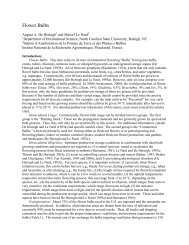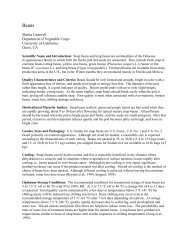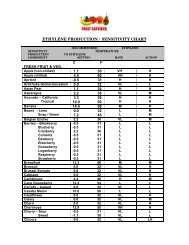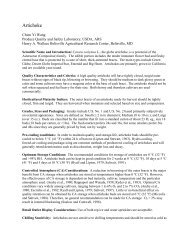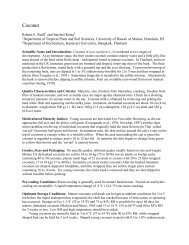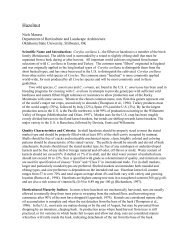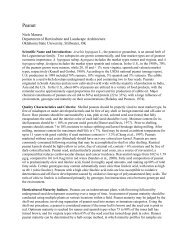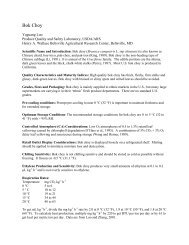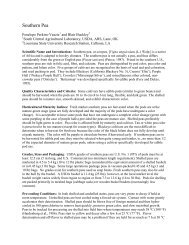Radish
Radish
Radish
Create successful ePaper yourself
Turn your PDF publications into a flip-book with our unique Google optimized e-Paper software.
<strong>Radish</strong>Richard LaMar HassellClemson University, Coastal Research and Education CenterCharleston, SCScientific Name and Introduction: The radish, Raphanus sativus, is a member of the Cruciferae family,native to Europe or Asia. It was once grown on a small scale in all areas of the U.S. and also as agreenhouse vegetable. However, mechanization of harvesting and handling has resulted in morecentralized production. The word raphanus comes from the Greek word meaning quick appearing oreasily grown. The roots are of many shapes, sizes and colors; eg., round, turnip-shaped, oval, oliveshaped, half-long or long. Color varies from white, pink-red, purple, yellow or even black. However, themost common radish is oval with a dark red skin and white flesh (Thompson and Kelly, 1957; Maynardand Hochmuth, 1997).Quality Characteristics and Criteria: <strong>Radish</strong>es should be fresh, well-colored, tender, firm, crisp,smooth with no ridges, free from dirt or other foreign material, and free from harvest cuts, abrasions andinsect damage. They should not be stringy or woody, soft, flabby, or wilted. Bunched radishes shouldhave fully intact tops that are dark-green with no yellowing; they may be slightly wilted. Size variesdepending on market demand, but larger roots are more likely to be pithy (Carione and Lucas, 1972;USDA, 1975; Thompson and Kelly, 1957).Horticultural Maturity Indices: Harvest maturity is based on size and market demand. The diameter ofoval types should be between 2 and 3 cm (0.75 to 1.25 in). Bunched radishes are harvested in eitherregular or big bunch size, and roots for cello packages are pulled at regular or jumbo size (Nonnecke,1989).Grades, Sizes and Packaging: There are two USDA grades for topped and bunched radishes: U.S. No. 1and U.S. Commercial. Bunched radishes have full-length tops tied in bunches, while topped radisheshave clipped tops no more than 1 cm (0.38 in) long. Root diameters are termed: Small, 1.9 cm (0.75 in);Medium, 1.9 to 2.5 cm (0.75 to 1.0 in); Large 2.5 to 3.2 cm (1 to 1.25 in); and Very Large 3.2 cm (over1.25 in). U.S. No.1 roots have similar varietal characteristics and are clean, well formed, smooth, firm,and tender. They are also free from decay, cuts, pithiness, or disease, and from damage caused byfreezing, growth cracks, insects or other means. Bunched radishes have tops that are fresh and free fromdecay and damage caused by freezing, seed stem, yellowing or other discoloration, diseases, insects orother means. In order to allow for variation in grading and handling, a 5 to 10% variation by count, areacceptable tolerances for a U.S. No. 1 grade product. If the variation > 10 but < 20%, they are designatedU.S. Commercial (USDA, 1968; Maynard and Hochmuth, 1997).<strong>Radish</strong>es are available in many size containers. Topped radishes are packed in 168 g (6 oz) 224 g (8oz), 454 g (1 lb), 2.3 kg (5 lb), 11 kg (25 lb) and 18 kg (40 lb) perforated plastic bags. Commonly, thirty168 g (6 oz), twenty-four 224 g (8 oz), or fourteen 454 g (1 lb) bags are boxed together for retail, while11 kg (25 lb) bags are used for the foodservice industry (Buurma, 1999).<strong>Radish</strong>es are first graded according to diameter to eliminate spikes (< 1.9 cm; 0.75 in) and toaccumulate Jumbo’s (> 3.8 cm, 1.25 in). The radishes are then conveyed over grading tables to removeproducts below acceptable grade standards. After being graded, cellos are packaged using vertical formfill machines. These machines form the breathable poly bag, weigh the specific amount of desiredradishes, seal the bag or provide a zipper locking system. These bags are then hand-packed into waxcartons and temporarily stored at 2.2 °C (36 °F) before shipment.
Pre-cooling Conditions: Hydro-cooling at 0 to 4.5 °C (32 to 40 °F) is the preferred method of precooling.Cello packs are hydro-cooled to restore crispness, bulk stored in bins, and then placed inrefrigerated coolers prior to grading. Bunched radishes are dipped in chlorinated water at 2.2 °C (26 °F),to restore crispness and freshness to the tops and roots, as well as to remove field debris. They are thenpacked into cartons, usually 24 bunches per carton, hydro-cooled and the carton topped with an ice slurrybefore shipping (Ryall and Lipton,1972b; Brooker and Pearson, 1970).Optimum Storage Conditions: Topped radishes can be held 3 to 4 weeks at 0 °C (32 °F) with 90 to95% RH, and at least 7 days at 7.2 °C (45 °F). Bunch radishes are harder to keep fresh due to theperishability of the tops. However, they can be held at 0 °C (32 °F) and 90 to 95% RH for 1 to 2 weeks.Winter or black radishes can be stored under the same conditions for 2 to 4 mo. Addition of top ice aidsin keeping the tops fresh (Ryall and Lipton, 1972a).Controlled Atmosphere (CA) Conditions: A 1 to 2% O 2 + 2 to 3% CO 2 CA at 0 to 5 °C (32 to 41 °F)slightly extends storage-life (Ryall and Lipton, 1972b; Saltveit, 1997).Retail Outlet Display Considerations: Packaged radishes should be placed in a refrigerated rack.Bunch radishes should be refrigerated, and can be iced or misted to help preserve quality.Chilling Sensitivity: <strong>Radish</strong>es are not sensitive; store as cold as possible without freezing.Ethylene Production and Sensitivity: <strong>Radish</strong>es produce small amounts of ethylene and are notparticularly sensitive to ethylene exposure.Respiration Rates:Topped Roots Bunched Roots with TopsTemperature (mg CO 2 kg -1 h -1 )0 °C 14 to 17 3 to 94 to 5 °C 19 to 21 6 to 1310 °C 31 to 36 15 to 1615 to 16 °C 70 to 78 22 to 4220 to 21 °C 124 to 136 44 to 5825 to 27 °C 158 to 193 60 to 89To get mL kg -1 h -1 , divide the mg kg -1 h -1 rate by 2.0 at 0 °C (32 °F), 1.9 at 10 °C (50 °F), and 1.8 at 20 °C(68 °F). To calculate heat production, multiply mg kg -1 h -1 by 220 to get BTU per ton per day or by 61 toget kcal per metric ton per day. Data are from Hardenburg et al., 1986.Physiological Disorders: Freezing injury can cause softening and shriveling, and leakage of pigment forred radishes. Growth cracks or air cracks reduce quality when they are > 6 mm (0.25 in) deep andassociated with discolored tissue. Over-maturity or stress during growth can induce dry, cottony voids inroots called pithiness. Yellowing of tops can result from over-maturity or exposure to ethylene orelevated storage temperature (Murry,1977; Nonnecke,1989).Postharvest Pathology: The initial lesions of bacterial black spot (Xanthomonas vesicatoria) are brownand have a diameter of 1.0 to 2.5 mm (0.04 to 0.1 in). They eventually turn black and coalesce.Protective measures include washing in water with 100 to 200 ppm of chlorine. Downy mildew(Peronospora parasitica) produces purplish-red to brown surface lesions that become rough and crackedin advanced cases, while the internal tissue can become grayish brown to black. Rhizoctonia root rot(Rhizoctonia solani) produces lesions that are initially round and light brown, and that can become
slightly sunken. The tissue can become spongy. This disease favors high RH. Avoid bruising, hydrocoolto 4.4 °C (40 °F) and store at 0 to 1.7 °C (32 to 35 °F) to control these diseases (Ryall and Lipton,1972b).Quarantine Issues: NoneSuitability as Fresh-cut Product: Currently radishes are cut or diced in packaged salad mixes, and forfoodservice, particularly for incorporation into salad bars.Special Considerations: NoneReferences:Brooker, J. and J. L. Pearson. 1970. Planning data for marketing selected fruits and vegetables in thesouth, Part III, Fresh Vegetable Packing Handbk. Bull. 152. Southern Cooperative Series.Buurma, L. 1999. Personal communication, Buurma Farm, Inc., Willard OH.Carcione, J. and B. Lucas. 1972. The greengrocer; the consumer’s guide to fruits and vegetables.Chronicle Books, San Fran.Hardenburg, R.E., A.E. Watada and C.Y. Wang. 1986. The commerical storage of fruits, vegetables, andflorist and nursery stock. USDA Handbook No. 66, 94 pp.Maynard D.N. and G.J. Hochmuth 1997. Knott’s Handbook for Vegetable Growers, 4th Edition.Nonnecke, I.L. 1989. Vegetable production/radish. Van Nostrand Reinhold, 115 Fifth Ave., NY, pp. 339-346.Murry J. 1977. Fruit and vegetable facts and pointers (<strong>Radish</strong>). United Fresh Fruit and VegetableAssociation, Washington, D.C.Ryall, A.L. and W.J. Lipton. 1972a. Longer storage-life for radishes. Agric. Res., Vol. 20, No. 7.Ryall, A. L. and W. J. Lipton, 1972b. Handling, transportation and storage of fruits and vegetables, Vol.1. AVI Pub. Co., Westport CT.Saltveit, M.E. 1997. A summary of CA and MA requirements and recommendations for harvestedvegetables. In: 7 th Intl. Contr. Atmos. Res. Conf. Vol. 4, Vegetables and ornamentals. Univ. Calif.,Davis, Postharv. Hort. Series 18:98-117.Thompson H.C. and W.C. Kelly. 1957. Vegetable Crops, McGraw-Hill Book Co., NY.USDA. 1968. U.S. standards for grades of radishes. Consumer Market. Serv. www.usda.gov.USDA. 1975. How to buy for economy and quality; recommendations of USDA, Dover Pub, NY.



